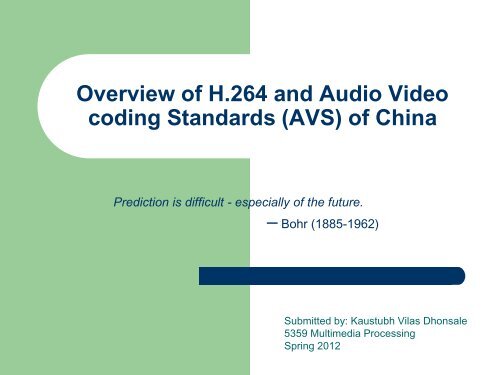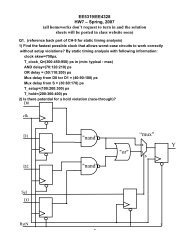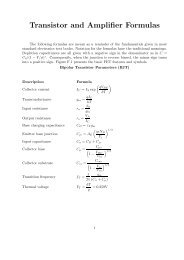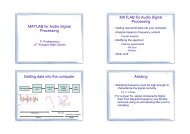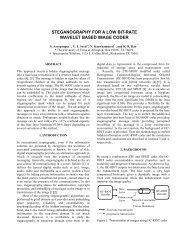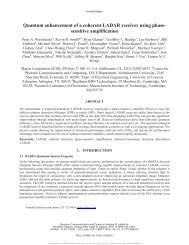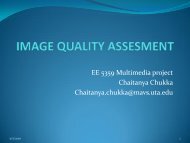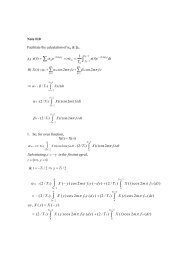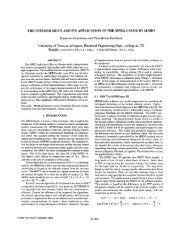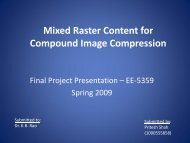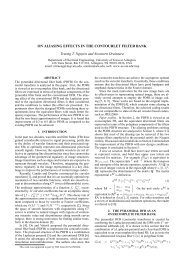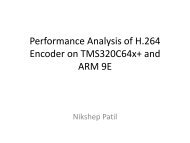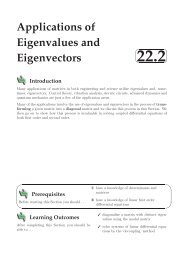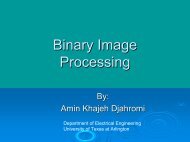Overview of H.264 and Audio Video coding Standards (AVS) of China
Overview of H.264 and Audio Video coding Standards (AVS) of China
Overview of H.264 and Audio Video coding Standards (AVS) of China
Create successful ePaper yourself
Turn your PDF publications into a flip-book with our unique Google optimized e-Paper software.
<strong>Overview</strong> <strong>of</strong> <strong>H.264</strong> <strong>and</strong> <strong>Audio</strong> <strong>Video</strong><br />
<strong>coding</strong> St<strong>and</strong>ards (<strong>AVS</strong>) <strong>of</strong> <strong>China</strong><br />
Prediction is difficult - especially <strong>of</strong> the future.<br />
– Bohr (1885-1962)<br />
Submitted by: Kaustubh Vilas Dhonsale<br />
5359 Multimedia Processing<br />
Spring 2012
Outline<br />
• Introduction<br />
• MPEG -4 AVC/ <strong>H.264</strong><br />
• <strong>AVS</strong> <strong>of</strong> <strong>China</strong><br />
• Problem Statement<br />
• Proposed solution<br />
• Summary<br />
2
Introduction<br />
3<br />
Fig. 1 Example <strong>of</strong> multimedia ecosystem. [1]
<strong>Audio</strong>/<strong>Video</strong> History<br />
4<br />
Fig. 2 History <strong>of</strong> audio <strong>and</strong> video st<strong>and</strong>ards [2]
MPEG -4 AVC/ <strong>H.264</strong><br />
• Moving Picture Experts Group (MPEG)<br />
formed in 1988<br />
• Focused on creating a simple <strong>and</strong> clean<br />
solution, limiting options <strong>and</strong> features to a<br />
minimum for video <strong>and</strong> audio data<br />
• Has seven pr<strong>of</strong>iles each targeted to specific<br />
class <strong>of</strong> application<br />
5
Pr<strong>of</strong>iles <strong>of</strong> <strong>H.264</strong><br />
• Baseline pr<strong>of</strong>ile<br />
• Extended pr<strong>of</strong>ile<br />
• Main pr<strong>of</strong>ile<br />
• High pr<strong>of</strong>ile<br />
• High 10<br />
• High 4:2:2<br />
6<br />
• High 4:2:2 predictive
Advantages <strong>of</strong> <strong>H.264</strong><br />
• Up to 50% in bit rate savings[2]<br />
• High quality video<br />
• Error resilience<br />
• Network friendliness<br />
• Wide area <strong>of</strong> applications<br />
7
<strong>AVS</strong> <strong>of</strong> <strong>China</strong><br />
• Developed by a working group <strong>of</strong> <strong>China</strong> named as<br />
“<strong>Audio</strong> video <strong>coding</strong> St<strong>and</strong>ard”[3]<br />
• Originally was developed to replace MPEG 2 format<br />
• Comprises <strong>of</strong> two different parts—<br />
• <strong>AVS</strong> Part 2<br />
High-definition digital video broadcasting <strong>and</strong> high-density<br />
storage media<br />
• <strong>AVS</strong> Part 7<br />
– for low complexity, low resolution mobility applications<br />
8
Basic Pr<strong>of</strong>iles<br />
Pr<strong>of</strong>iles<br />
Jizhun (baseline) pr<strong>of</strong>ile<br />
Jiben (basic) pr<strong>of</strong>ile<br />
Shenzhan (extended) pr<strong>of</strong>ile<br />
Jiaqiang (enhanced) pr<strong>of</strong>ile<br />
Key Applications<br />
Television broadcasting, HDTV, etc.<br />
Mobility applications, etc.<br />
<strong>Video</strong> surveillance, etc.<br />
Multimedia entertainment, etc.<br />
Table 1 Application based pr<strong>of</strong>iles <strong>of</strong> <strong>AVS</strong> <strong>of</strong> <strong>China</strong> [4]<br />
9
<strong>Video</strong> evaluation parameters<br />
• Peak Signal to Noise Ratio (PSNR)<br />
• Mean Square Error (MSE)<br />
• Structural Similarity (SSIM)<br />
10
Performance comparison<br />
parameters<br />
• Simulation with different test sequences<br />
• Bit rate<br />
• Quality<br />
• PSNR<br />
• MSE<br />
• SSIM<br />
• Compression ratio<br />
• Latency<br />
11
Expected outcomes<br />
• Familiarity with st<strong>and</strong>ards<br />
• Simulation <strong>of</strong> the codecs<br />
– Modes <strong>of</strong> Configuration<br />
– Modification <strong>of</strong> Parameters<br />
– Input sequence specifications<br />
– Analyze the codec output<br />
• Identify areas <strong>of</strong> research <strong>and</strong> unexplored problems<br />
• Comparing the outcomes for both systems<br />
12<br />
• Efficient use <strong>of</strong> time <strong>and</strong> re-use <strong>of</strong> knowledge
Timeline<br />
‣ Implementation<br />
<strong>AVS</strong> <strong>of</strong> <strong>China</strong>---------------April 1 st<br />
MPEG -4 <strong>AVS</strong> / <strong>H.264</strong>---------------------------------April 21 st<br />
‣ Documentation<br />
Tabulation <strong>of</strong> initial results –-------------April 5 th<br />
Report writing---------------------------------------April 20 th<br />
Submit draft <strong>of</strong> final report ------------------------April 26 th<br />
‣ Final<br />
Final project report <strong>and</strong> presentation--------------------------May 3 rd<br />
13
References<br />
14<br />
1. <strong>AVS</strong> <strong>Video</strong> Expert Group, “Information technology – Advanced <strong>coding</strong> <strong>of</strong> audio <strong>and</strong> video – Part 2:<br />
<strong>Video</strong> (<strong>AVS</strong>1-P2 JQP FCD 1.0),” <strong>Audio</strong> <strong>Video</strong> Coding St<strong>and</strong>ard Group <strong>of</strong> <strong>China</strong> (<strong>AVS</strong>), Doc. <strong>AVS</strong>-N1538,<br />
Sep. 2008<br />
2. ITU H.263 <strong>Video</strong> Compression : http://www.h263l.com/<br />
3. J. Watkinson, “The MPEG H<strong>and</strong>book”, Second Edition, Elsevier/Focal Press, pp. 1, 2004.<br />
4. “Advanced <strong>Audio</strong> <strong>Video</strong> Coding St<strong>and</strong>ard Part 2: <strong>Video</strong>”, <strong>Audio</strong> <strong>Video</strong> Coding St<strong>and</strong>ard Group <strong>of</strong> <strong>China</strong><br />
(<strong>AVS</strong>), Doc. <strong>AVS</strong>-N1063, Dec, 2003.<br />
5. ] L. Yu, et al., “<strong>Overview</strong> <strong>of</strong> <strong>AVS</strong>-video <strong>coding</strong> st<strong>and</strong>ards”, Elsevier Press, Signal Processing: Image<br />
Communication, vol. 24, pp. 247-262, April 2009<br />
6. Thomas Wieg<strong>and</strong>, Gary J. Sullivan, Gisle Bjøntegaard, <strong>and</strong> Ajay Luthra, “<strong>Overview</strong> <strong>of</strong> the <strong>H.264</strong>/AVC<br />
<strong>Video</strong> Coding St<strong>and</strong>ard”, IEEE transactions on circuits <strong>and</strong> systems for video technology, VOL. 13, NO. 7,<br />
JULY 2003.<br />
7. Liang Fan, Siwei Ma, Feng Wu, “<strong>Overview</strong> <strong>of</strong> <strong>AVS</strong> <strong>Video</strong> St<strong>and</strong>ards”, IEEE International Conference on<br />
Multimedia <strong>and</strong> Expo (ICME), pp. 423-426, 2004.<br />
8. <strong>Audio</strong> <strong>Video</strong> Coding St<strong>and</strong>ard Workgroup <strong>of</strong> <strong>China</strong> (<strong>AVS</strong>), “<strong>Video</strong> Coding St<strong>and</strong>ard FCD1.0”, NOV.2003.<br />
9. <strong>AVS</strong> <strong>Video</strong> Expert Group, “Information Technology —Advanced <strong>Audio</strong> <strong>Video</strong> Coding St<strong>and</strong>ard Part 7:<br />
Mobility <strong>Video</strong>”, <strong>Audio</strong> <strong>Video</strong> Coding St<strong>and</strong>ard Group <strong>of</strong> <strong>China</strong> (<strong>AVS</strong>), Doc. <strong>AVS</strong>-N1151,Dec.2004<br />
10. Z. Wang, et al “Image quality assessment: From error visibility to structural similarity”, IEEE Trans. on<br />
Image Processing, vol. 13, pp. 600-612, Apr. 2004.
15<br />
Thanking you <strong>and</strong> any Q/A


